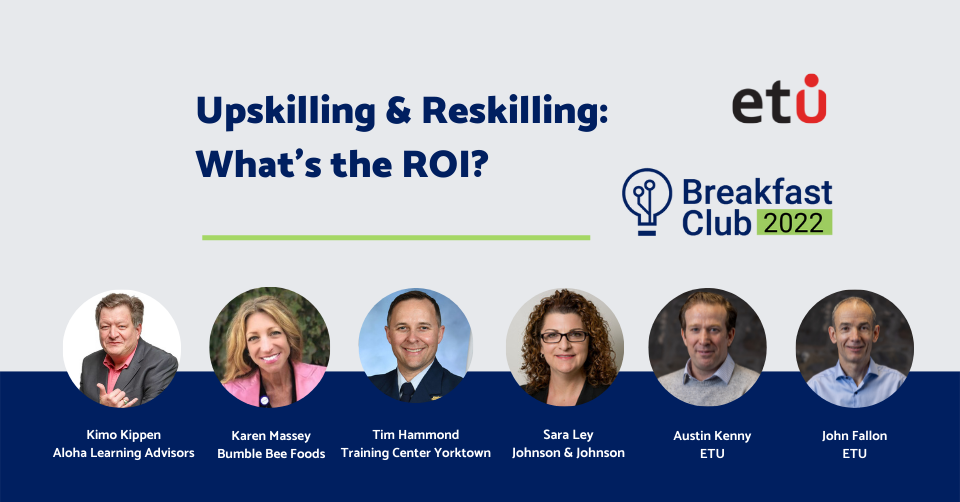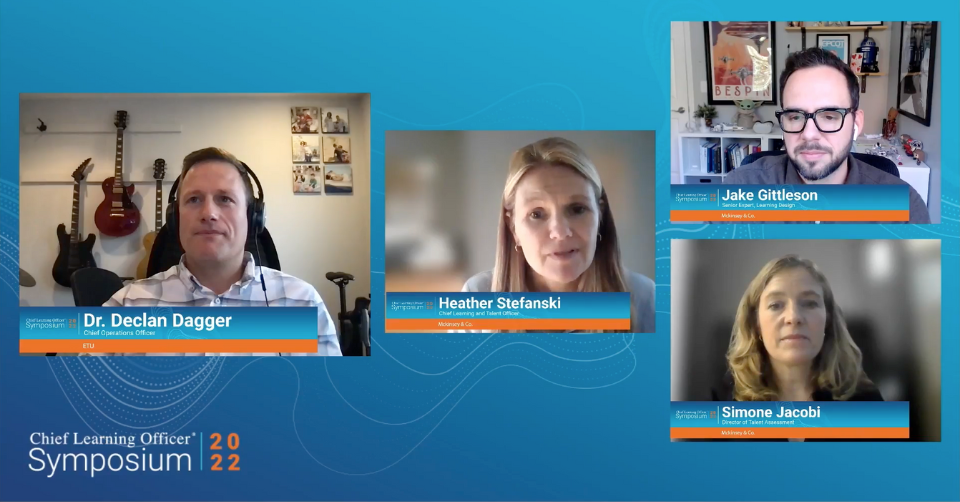
CLO Panel: Upskilling & reskilling - what’s the ROI?
In this CLO panel discussion, we asked a group of top L&D experts about how they measure the ROI of their upskilling and reskilling training programs.
Metrics and data are paramount in helping organizations gain a deeper understanding of the impact of their L&D programs. As businesses are placing increased emphasis on upskilling and reskilling their workforce for the future of work, what should they be measuring to ensure their initiatives are having the desired impact on skill gaps?
Panel discussion
Watch this panel session of industry leaders as they come together to review the ROI around upskilling and reskilling.
In this short extract, panelists share approaches to identifying skills of the greatest need and how they're going about focusing on skill development.
Speakers:
- Kimo Kippen, Founder, Aloha Learning Advisors
- Karen Massey, Director of Learning and Development, Bumble Bee Foods
- Capt. Timothy Hammond, Commanding Officer, U.S. Coast Guard Training Center Yorktown
- Sara Ley, Head of Digital & Tech Practice, Senior Director, Johnson & Johnson
- Austin Kenny, Chief Revenue Officer, ETU
- John Fallon, Director of Product Marketing, ETU
FastTalk and speed round
New immersive learning methods allow enterprises to scale powerful upskilling approaches to thousands of learners globally. And scale isn’t the only benefit – skill measurement data from these immersive simulations can be used to personalize learning journeys. It’s the personalization at scale that optimizes learners’ seat times and provides the ROI required to re-imagine learning programs.
Watch this session delivered by John Fallon and Austin Kenny as they share their experience from a program that is on track to generate $13 million in savings as it scales upskilling to 100,000 learners.
Insights from live poll
The live Breakfast Club event was attended by over 200 learning and development professionals who shared their views on upskilling strategies and priorities.
Insight 1 - seat-time savings
71% of learning professionals stated that seat-time savings are important to upskilling ROI.
Insight 2 - testing out
79% of learning professionals use testing-out as part of their designs
Insight 3 - critical or "soft" skills
95% of learning professionals find soft skills more difficult to measure.
Insight 4 - shrinking content length
80% of learning professionals see the ideal length of digital learning content as less than 20 minutes
with 34% of the view that it should be less than 10 minutes.
Insight 5 - continued need for leadership development
Clearly, the most important area for upskilling is leadership with 85% of learning professionals calling this out, with DEI next most important at 46%.
Panel Discussion continued
Watch this complete recording of the panel session here.
Transcript highlights
Kimo Kippen
The use of simulations that you've mentioned, that can be a very positive way, because it actually puts the learner right into a situation that they have to respond. And then I think what you also mentioned was really good was remediation, right? So where there was a need, you know, it's like, it's not that, you know, even if you, you didn't maybe get it right the first time, but after the remediation, you've had the opportunity to get it right. And that's really, what's more important about, it's not about being right. It's about getting it right. You know, and that, again, that's, that's part of that learning process to help people move, move there.
Sara Ley
I will jump in on the ROI from a bit of a different focus space. So I mentioned, that I worked for GE for a while, and, and we used to say ROI was just assumed. It wasn't something we set out or expected from leaders to measure. So that was interesting for many of us who've been in the learning space that we just knew it was effective. The return on investment was there and then shifting into PWC and leading their digital upskilling, which was around their business transformation. How they tech-enabled and automated work with their clients. And the effort was around upskilling everyone, right? So the entire firm and going about that in a, in leveraging a lot of different programs and channels, but then how do you know it was effective, right?
How do you measure? And we actually partnered with ETU around the simulation. So through putting the various, we'll call digital topics out there, the objectives, presenting those in a host of ways, then assessing them through, a diagnostic that was very simulation-based. And, you know, if they were successful at going through, they did earn a, a digital badge, which was their carrot. And it was incentivized from the firm, but also the change of behavior. Because the ultimate goal was changing how the firm worked with clients. And so the automations, the the use of the new tools that were being leveraged to do that work. There's a digital lab to share the automations, but the ability to also measure that and see that the shift in productivity savings, and streamlining things was super effective. There was also that shift in mindset and awareness of demystifying what digital is, what does that need, and having better conversations with the client base, internal, et cetera. And, how do you do that creatively and assess? I think simulations is a great way to use a diagnostic and because it's more than just, Hey, I attended this training, check the box.
Kimo Kippen
Great example. And you think about that whole digital transformation, which by the way, is top of mind for most senior leaders and obviously skills linked directly to that. The discussion then also is around that change of mindset. How do you create that change of mindset to we're gonna have to think about this digitally, making it scalable and repeatable?
Austin Kenny
It's a really interesting one about the future, you know? and it's, it's come up so much on this call already, like data, data data. You can see it manifest itself in the conversations right across the board, where, where I've seen the most successes with organizations that have moved the fastest and those organizations that can move at that rate in order to essentially get at that data. Because once organizations are getting access to the right learner analytics data, it completely changes the dynamic internally, it makes the conversations that they're having internally much more tangible, um, in terms of, in terms of what to do next, because the data we know, like the organizations that are making decisions based on data are the organizations that are going to win in the future. There are tons of reports out there, McKinsey have done the reports out there on it. But also we can see it because once that data lands, then the conversation goes up to the c-suite and the conversations for L and D at the c-suite around data and around how that data is informing the strategy and how that data is informing, where we're spending money and spending time to, to Sarah's point, you know, it completely changes the whole thing. So I'll pass it over to you, Tim. Thanks.
Capt. Timothy Hammond
I almost just say ditto, very solid, great points. I think from my perspective, a continuation of investing in the workforce, you know, throughout their careers helps to drive the retention, especially as it's centered towards the mission. So making sure that you're investing into the future. And so that way you're growing them up from within, I think it just speaks volumes to hopefully getting to executing the mission or getting to the marketplace and hopefully keeping that talent inside the fence line, so to speak.
Kimo Kippen
Great. Thank you to all of you, just quick summaries that I just took away from the four of your comments would be to practice and apply use of gigs. Stay connected to the business, having the right data and access it to it, which informs strategy, and then investing in the workforce and all in service of the mission of the organization.

